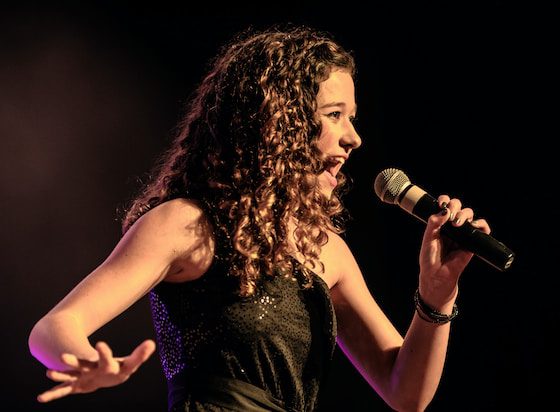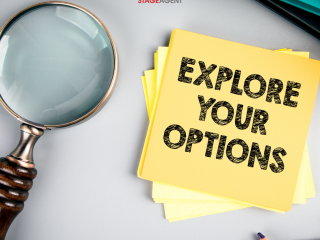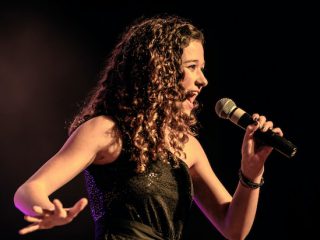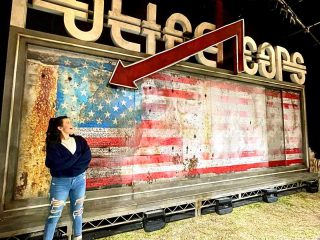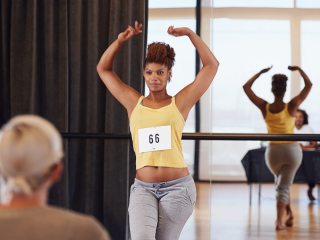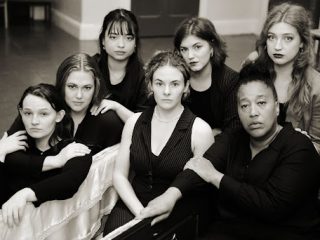Q: Let the people know who you are & what your multi-hyphenate title is.
Hi! I’m Bebe Brunjes, I’m a gender-fluid, non-binary performer (they/she/he). I like to think of myself as a “Jacqueline of all trade” – I am a member of the International Alliance of Theatrical Stage Employees (IATSE*) as a hair/wardrobe/makeup designer as well as a triple threat performer working mainly in musical theater.
*Editor note: IATSE is a union for behind-the-scenes entertainment workers.
Q: When did you first become involved in the arts?
Growing up in Barrie, Ontario I was the youngest of 5 kids and was exposed to a lot of music. My father was a singer/songwriter, as well as all my siblings played their own instruments. Naturally, around 7, I jumped into performing. I started dancing at the age of 12 because I was invited to learn a dance for a piano recital to N’Sync’s “Bye Bye Bye”, and that really led me down my dance journey. Dance was always SO fun, but I would be secretive, only dancing in my fenced backyard so no one would see me dance.
I was fortunate to go to a high school with a strong arts program. It was a big catalyst for who I am now. I went into it thinking I would be a band geek but moved more into the drama side of things. I fell into improv and theatrical productions. My first show was Joseph & the Amazing Technicolor Dreamcoat playing Benjamin.
I went to school in Ottawa for theater at the University of Ottawa. I wanted to be an actor, but immediately knew that I also needed to grab on to other skills in theater backstage if I wanted to be a part of the industry sooner. So, I used my love of visual arts to learn to paint sets and, since I had done a few makeup gigs for friends who were modeling, that quickly turned to designing makeup for theater shows, so I jumped right into that! During my second year, I was put in touch with a professional contact with IATSE who my professors thought would help me on my journey as a theater professional. From there, I learned to sew and got involved with wardrobe.
Q: Can you describe the job of a wig/makeup/wardrobe designer for us?
The job is what it sounds like – you are responsible for creating the wigs, makeup, or wardrobe for a production. Depending on your position within those departments, that can mean anything from designing, creating, and styling. As a designer who works in all three areas, I can be put anywhere I’m needed, which is always really useful and exciting. Being in wigs/makeup/wardrobe is a collaborative role on any production. You incorporate the script, director’s vision, actors’ thoughts, and your own perspective on the material – what are the given circumstances? How can you use design to communicate the story to the audience? You really have to find a way to combine the opinions of many people into one cohesive look.
Q: How did you first become involved in wigs/makeup/wardrobe?
Arguably, It’s a lot of fake it until you make it. You’re having to learn on the fly. I advocated for my skills and landed a designer role during my time at uni. I spent lots of time working on my own face to develop makeup skills and figure out what works. When I was asked to do hair design, I stepped up to the challenge. Again, it was a lot of trial and error in my own time.
Once I started working in the union (IATSE), I met my mentors who gave me the opportunity to learn by their side. Lizzie Ciesluk, Bev Chappell, Normand Couvrette, Linda Dusfresne all were huge mentors and influenced my journey. My first professional gig was doing makeup for a production of Cavalleria Rusticana/Pagliacci with Opera Lyra in Ottawa. . .opera makeup is BANANAS. I got to learn how to do the ensemble member’s makeup and taught on the fly, sitting next to my mentors who also taught me how to behave. They brought me in to Lizzie [Ciesluk] – she painted half of my face and then watched me paint the rest of her beautifully femme opera makeup. I learned so much about makeup design from her concept drawings – they were so exciting to look at.
Q: What is your favorite aspect of being in wigs/makeup/wardrobe and what do you find the most challenging?
My favorite part is that everything is new. Nothing is consistent which allows me to get to play. I get to play dress up, encourage others to create and be storytellers through visual art. My favorite part about designing is taking something that’s in my head, knowing that no one else can see it, and being able to bring it to life. I could write a love song about designing and performance. There’s so many aspects of design that go hand-in-hand with performing. As a dancer, there’s such a satisfying feeling when you put on an outfit that is the exact flowingness that you understand in your body. I never wanted my clothes to “just be on a hanger”; they’re supposed to be used in motion, to tell a story. I really feel that my training in performance gives me a symbiosis with design. As someone who does both, I understand both disciplines in a deeper way. I can bring a different level of connection to my art. I love the jaw drop when someone asks who did my clothes/wig/makeup, and I say I did all of it.
The biggest challenge is that there’s only one of me! I would love to be the head designer of a fashion house where I would have multiple people who I could pay to carry out my vision on a day-to-day basis. There’s so many ideas I have, but there’s only so much time in the day. I don’t want to choose one or the other, I love mixing all aspects of design and performance.
Q: For anyone looking to get into wigs/makeup/wardrobe, what advice would you give them?
Step One: Just do it. There are so many different outlets, platforms, and resources in terms of where to start learning how to do it. Makeup, hair, and sewing tutorials on YouTube have always been my best friend. You can start by stitching socks, putting on buttons, or fixing holes in your clothes to perfect hands stitching.
There’s always resources. Find a dollar store wig to learn how to style. There’s no reason to disregard hard front [wigs] and don’t play around with human hair wigs (until they are ethically sourced). I’d recommend playing with synthetic and even yak! For makeup, if you want to get better with brush work, play around with your own face or start painting! Spend a couple of dollars on beginner stuff and you can build a foundation.
Step Two: Talk to people. Reach out to people whose work you like or find inspiring. Not only will they give you words of encouragement, they will help you understand the process and give advice with what you’re working on. With social media, film and television, we see a lot of finished products but not all the work that goes into it.
Step Three: Get involved in the arts community. Once you’ve developed your craft, people will start reaching out. Volunteer – it’s important to develop skills and volunteering is a great way to practice. You can’t buy bagels with exposure, but it is incredibly necessary to keep up your skills.
Q: How has being a multi-hyphenate helped you on Sew Fierce, the design competition show?
There were pros and cons – showcasing myself on TV was one of the hardest things I’ve ever tried to do. Being on Sew Fierce gave me new appreciation for competition sewing. You don’t understand stress until you’re in this pressure cooker where there’s six cameras on you as you’re trying to build your design into reality.
Coming from a theatrical background, I knew that the show was going to be a collaborative process with someone else doing wigs and makeup. The process was very difficult honestly. I never had so many people working for me and it was very hard to let go of the control of aspects of the full aesthetic that were going to reflect on my work. Just focusing on sewing and not the other components was my biggest challenge. Ultimately, I think it was to my benefit because I learned so much about myself as a designer and got to recognize that I’m a storyteller through design.
Q: Any parting thoughts?
Be nicer to yourself. I think that’s the hardest lesson for us artists to learn. We need to be kinder to ourselves because there’s always people looking to tear you down. You have to be your own biggest fan. If you can’t support yourself, who else is going to?
Nurture the love of your art. Sometimes it’s not about being the best and instead it’s about being on your own team. Make that paper bag dress, slap on some non-waterproof eyeliner, and go wild. Even in the worst moments, find your own joy.
Lastly, keep pushing for change. There’s more progress beginning in musical theater but there’s so many more stories to be told around different races, bodies and gender. Musical theater is a baby art form, it’s less than 2 centuries old! It can feel stilted, but if we keep pushing for progress, it will come.
A huge thanks to Bebe for giving us insight on all things design! Follow them on social media using @bebebrunjes on Instagram/Twitter/Tiktok.

